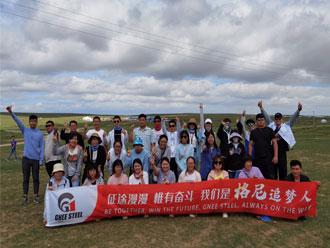Martensitic stainless steel sheets AISI 410
| Chemical Composition of 410 |
| Grade |
The Element (%) |
| C |
Si |
Mn |
P |
S |
Cr |
| 410 |
0.08 - 0.15 |
≤1.00 |
≤1.00 |
≤0.035 |
≤0.030 |
11.50 - 13.50 |
| Grade |
GB |
DIN |
AISI |
JIS |
| |
1Cr13 |
1.4006 |
410 |
SUS410 |
410S is annealed, or softened, to make it less brittle. This is done by heating it to between 1600 – 1650°F (871 – 899°C), then air cooling it slowly at room temperature to relieve cold-working stresses.Sometimes, if excessive large grains are encountered after annealing mildly cold-worked material, the annealing temperature should be decreased to a range of 1200 – 1350°F (649 – 732°C) range. However, it should never be increased to 2000°F (1093°C) or above due to embrittlement, which is the partial or complete loss of the material’s ductility, the opposite of the desired result of annealing 410S.
For maximum corrosion resistance to chemical environments, the 410S surface should be free of all heat tint or oxide formed during the annealing or hot working process. It is essential that all traces of oxide and surface decarburization be removed by grounding or polishing all surfaces. Afterwards, parts are immersed in a 10% to 20% nitric acid solution followed by a water rinse. This is to ensure the removal of any residual Iron.
After this step, stainless steel 410S parts are generally considered able to undergo welding by common fusion and resistance techniques, though special attention is paid in order to avoid brittle weld fractures during fabrication and to minimize discontinuities.
The main difference between stainless steel 410 and 410S is that 410 is a basic, general purpose, martensitic stainless steel that can be hardened whereas 410S is a lower Carbon modification of 410 stainless steel, more easily welded but possessing reduced mechanical properties. 410S stainless steel can be easily formed by drawing, spinning, bending, and roll forming.
pplications using 410S Chromium ferritic stainless steel have considerably increased in recent years in chemical industries as well as oil or gas transportation industries. Experiments to determine phase transformation temperatures are ongoing to determine the alpha to gamma transformation temperatures for this alloy in different cooling conditions. Results will determine how 410S can be best used in these industries.






















 Russian
Russian  Albanian
Albanian  Arabic
Arabic  Amharic
Amharic  Azerbaijani
Azerbaijani  Irish
Irish  Estonian
Estonian  Odia (Oriya)
Odia (Oriya)  Basque
Basque  Belarusian
Belarusian  Bulgarian
Bulgarian  Polish
Polish  Bosnian
Bosnian  Persian
Persian  Afrikaans
Afrikaans  Tatar
Tatar  Danish
Danish  German
German  French
French  Filipino
Filipino  Finnish
Finnish  Frisian
Frisian  Khmer
Khmer  Georgian
Georgian  Gujarati
Gujarati  Kazakh
Kazakh  Haitian Creole
Haitian Creole  Korean
Korean  Hausa
Hausa  Dutch
Dutch  Kyrgyz
Kyrgyz  Galician
Galician  Catalan
Catalan  Czech
Czech  Kannada
Kannada  Corsican
Corsican  Croatian
Croatian  Kurdish (Kurmanji)
Kurdish (Kurmanji)  Latin
Latin  Latvian
Latvian  Lao
Lao  Lithuanian
Lithuanian  Luxembourgish
Luxembourgish  Kinyarwanda
Kinyarwanda  Romanian
Romanian  Malagasy
Malagasy  Maltese
Maltese  Marathi
Marathi  Malayalam
Malayalam  Malay
Malay  Macedonian
Macedonian  Maori
Maori  Mongolian
Mongolian  Bengali
Bengali  Myanmar (Burmese)
Myanmar (Burmese)  Hmong
Hmong  Xhosa
Xhosa  Zulu
Zulu  Nepali
Nepali  Norwegian
Norwegian  Punjabi
Punjabi  Portuguese
Portuguese  Pashto
Pashto  Chichewa
Chichewa  Japanese
Japanese  Swedish
Swedish  Samoan
Samoan  Serbian
Serbian  Sesotho
Sesotho  Sinhala
Sinhala  Esperanto
Esperanto  Slovak
Slovak  Slovenian
Slovenian  Swahili
Swahili  Scots Gaelic
Scots Gaelic  Cebuano
Cebuano  Somali
Somali  Tajik
Tajik  Telugu
Telugu  Tamil
Tamil  Thai
Thai  Turkish
Turkish  Turkmen
Turkmen  Welsh
Welsh  Uyghur
Uyghur  Urdu
Urdu  Ukrainian
Ukrainian  Uzbek
Uzbek  Spanish
Spanish  Hebrew
Hebrew  Greek
Greek  Hawaiian
Hawaiian  Sindhi
Sindhi  Hungarian
Hungarian  Shona
Shona  Armenian
Armenian  Igbo
Igbo  Italian
Italian  Yiddish
Yiddish  Hindi
Hindi  Sundanese
Sundanese  Indonesian
Indonesian  Javanese
Javanese  Yoruba
Yoruba  Vietnamese
Vietnamese  Hebrew
Hebrew  Icelandic
Icelandic



























.jpg)
.jpg)




.jpg)
.jpg)
.jpg)
.jpg)
.jpg)






.jpg)
.jpg)


.jpg)
.jpg)
.jpg)



